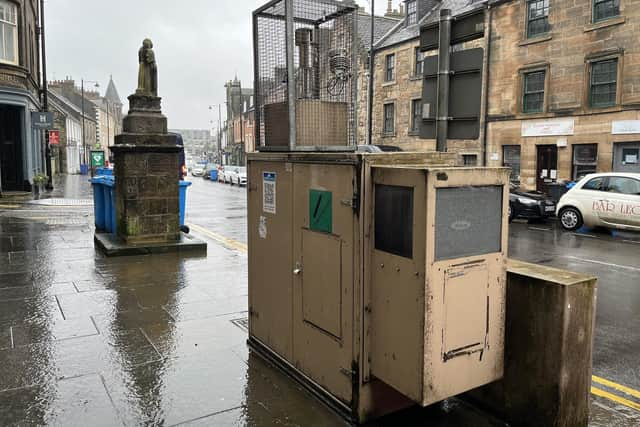Air quality monitors in Linlithgow and Newton to be removed
and live on Freeview channel 276
The testing stations, which resemble ventilation shafts for underground bunkers, have occupied prominent sites in both communities.
In Linlithgow the apparatus sits just yards from the A-listed St Michael’s Well – testament to the 21st century’s effect on the ancient burgh’s thoroughfare.
Advertisement
Hide AdAdvertisement
Hide AdIt was installed almost a decade ago when the testing was set up in both communities in 2016.


In a report to a recent meeting of the council’s Executive councillors heard that air quality had improved constantly since that year to the point where the council no longer needed to regularly monitor.
A report to the committee added: “There is no specifically identifiable reason for improvements in air quality over this time, but it is reasonable to assume that as vehicle pollution is the most significant factor causing poorer air quality, the “greening” of vehicles and newer, less polluting vehicles on our roads will have had a significant effect.
“This could also be considered alongside changes in driving behaviour, move from diesel vehicles, less vehicle use and similar.
Advertisement
Hide AdAdvertisement
Hide AdHowever Linlithgow’s Lib Dem Councillor Sally Pattle, who also runs a book store on the town’s main street told the meeting she was “nonplussed” and questioned whether increasing traffic meant monitoring needed to be something that was continual.
She later told the Local Democracy Reporting Service: “While I’m pleased that the data being collected by the air quality monitoring systems in both Newton and Linlithgow has shown a consistent decrease in the pollutants they are testing for, I’m not sure this is the whole story.
“Removal of the air quality monitoring systems certainly doesn’t mean that there’s been a reduction in traffic. In fact for those of us that live or work on Linlithgow High Street, and for everyone living in Newton, we know that there’s been an increase in the volume of vehicles in the past few years.
“I am concerned that particulate matter emitted from friction and wear and tear in vehicles is not being monitored, and could possibly pose a health risk.
Advertisement
Hide AdAdvertisement
Hide Ad“So, while it’s good that there’s been a transition to cleaner engines, vastly decreasing engine pollutants, I don’t think that’s the end of the story – I think we need to look at the issue differently in terms of what type of data is collected.”
While many would like to see the apparatus gone for purely aesthetic reasons the council teams who have overseen the monitoring process are happy at the potential savings. Supplying parts for the machinery is an expensive process. The removal of the statutory testing areas across the county including Broxburn, will save the council thousands of pounds a year.
Council officers from Environmental Health have now started the lengthy consultation process, with other departments within the council as well as the Scottish Government and other agencies.
And while the apparatus is no longer testing it could sit in-situ for many months.
Advertisement
Hide AdAdvertisement
Hide AdA spokesperson for West Lothian Council said: “Council Executive have given their approval to start the process of revoking the air quality management areas in Linlithgow and Newton.
“We are now seeking Scottish Government approval, which would allow us to begin a consultation with local elected members and interested parties over the plans.
“This can be a lengthy process, which will influence any decisions on future air monitoring arrangements. Therefore, we are unable to give definitive time-scales at this stage.”